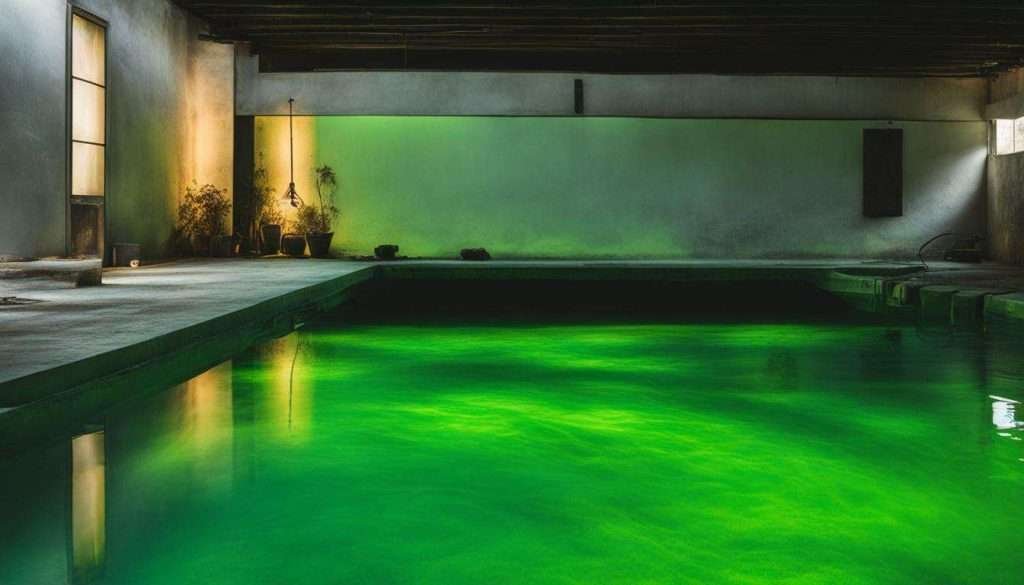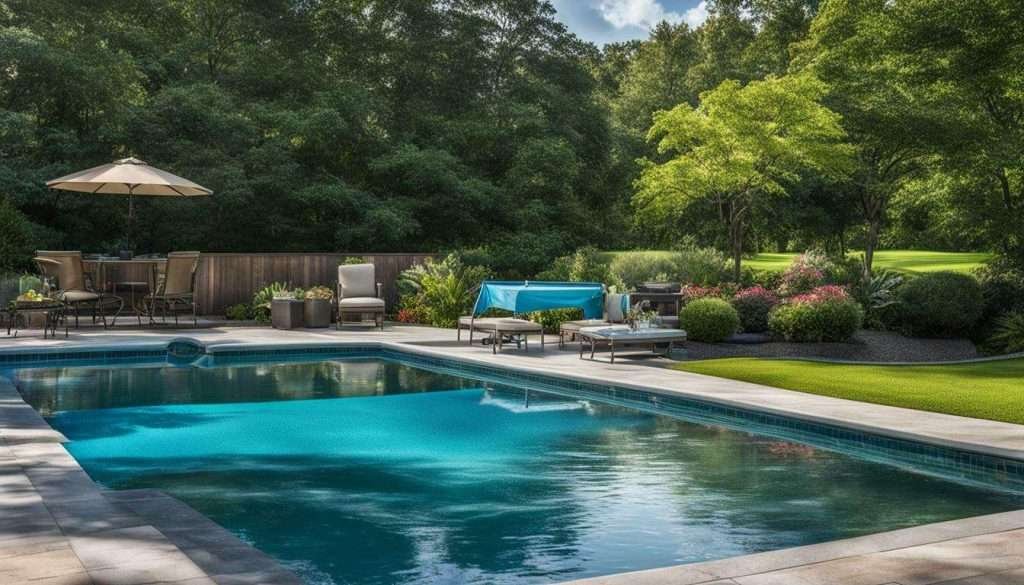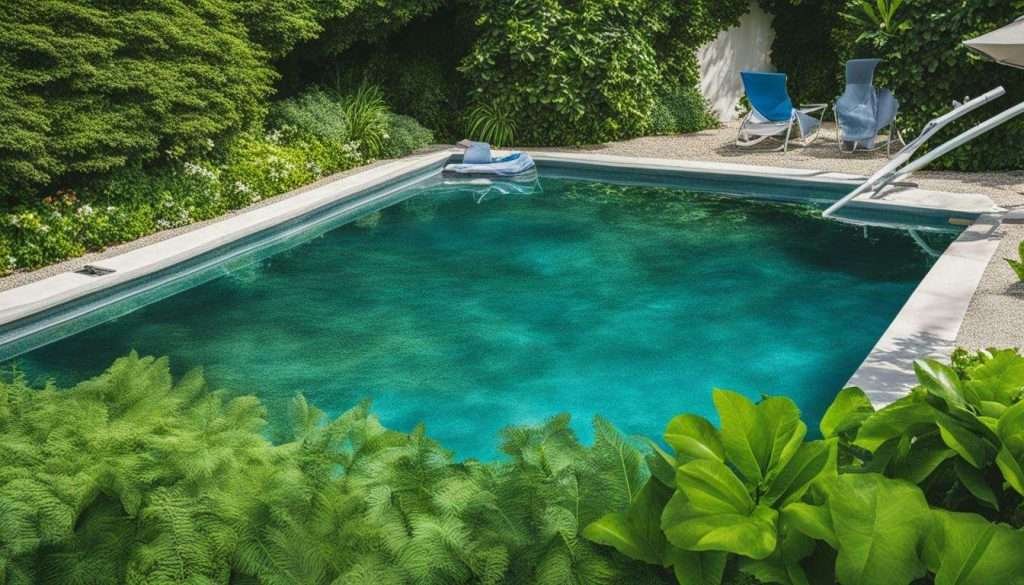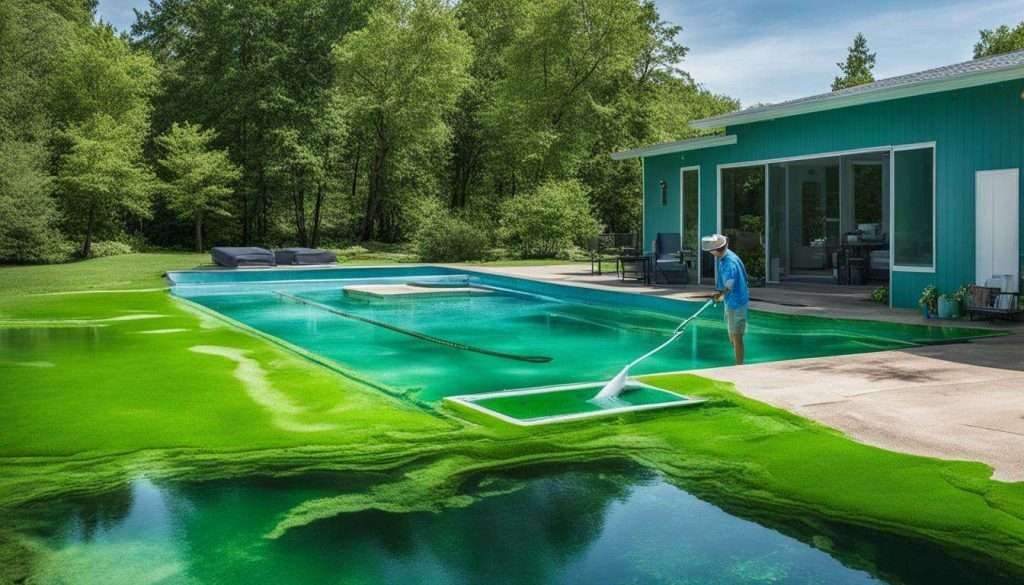Discover what to do if your pool water turns green and learn effective pool care tips to resolve this issue. If your pool water turns green, it could be a sign of algae growth due to imbalanced pH and chlorine levels. To resolve this issue, start by testing the water and adjusting the chemical levels accordingly. You may also need to shock the pool to kill off existing algae. Another important factor to consider is the pool cover impact on water circulation and sunlight exposure, as these can also contribute to algae growth. Regular maintenance and proper use of a pool cover can help prevent future instances of green pool water.
Key Takeaways:
- If your pool water turns green, it is likely due to an algae overgrowth caused by low chlorine levels and warm temperatures.
- To treat a light green pool, shock the water with a treatment to increase chlorine levels, brush the pool walls and floor to remove algae, let the pool pump run for 24 hours to filter the water, test the chlorine levels and add more if necessary, and maintain regular pool cleaning and maintenance to prevent future algae growth.
- Avoid swimming in the pool while shocking it, as high chlorine levels can be harmful to the skin and eyes.
- If the pool water is dark green or almost black, professional draining, acid washing, and refilling may be necessary.
- Other factors that can cause green pool water include heavy rains, heat waves, water circulation problems, and high levels of copper ions.
Understanding the Causes of Green Pool Water
To effectively treat green pool water, it’s important to understand the causes behind it. When your pool water turns green, it is likely due to an overgrowth of algae caused by low chlorine levels, warm temperatures, or a combination of both. Other factors such as heavy rains, heat waves, water circulation problems, and high levels of copper ions can also contribute to the growth of algae and the resulting green color.
Algae thrive in an environment with limited chlorine and warm temperatures, creating the perfect conditions for their growth. If your pool water has insufficient chlorine levels, the algae can quickly multiply and turn the water green. Similarly, warm temperatures accelerate algae growth, making it crucial to maintain proper chlorine levels and regulate the pool’s temperature.
To determine the cause of your green pool water, it is essential to consider recent weather conditions, water testing results, and the effectiveness of your pool’s circulation system. By identifying the specific cause, you can take the appropriate steps to treat the issue and prevent future occurrences.
| Cause of Green Pool Water | Solution |
|---|---|
| Low Chlorine Levels | Shock the water with a treatment to increase chlorine levels and maintain regular pool maintenance to prevent future algae growth. |
| Warm Temperatures | Regulate the pool’s temperature and ensure proper chlorine levels to control algae growth. |
| Heavy Rains | Monitor water levels and adjust chlorine levels accordingly. Maintain regular pool maintenance to prevent algae growth. |
| Heat Waves | Lower the pool’s temperature if possible and maintain appropriate chlorine levels. |
| Water Circulation Problems | Check the pool’s circulation system for any issues and ensure proper filtration and water flow. |
| High Levels of Copper Ions | Test for copper levels in the water and address any excess copper through appropriate treatment. |
By addressing the specific cause of your green pool water, you can take the necessary steps to treat the issue effectively. Understanding the causes and implementing the appropriate remedies will help you restore clear water and maintain a healthy pool environment for you and your family to enjoy.
Treating a Light Green Pool
Here’s what you should do to treat a light green pool and restore clear water. If your pool water has turned green, it is likely due to an algae overgrowth caused by low chlorine levels and warm temperatures. Follow these steps to get your pool back in shape:
- Shock the pool water: Use a shock treatment to increase the chlorine levels in your pool. This will help kill the algae and restore clear water.
- Brush the pool walls and floor: Use a pool brush to scrub the walls and floor of your pool. This will help remove any algae that may be clinging to the surfaces.
- Run the pool pump: Allow the pool pump to run for at least 24 hours to help filter out the algae and debris from the water.
- Test and balance the chlorine levels: Test the chlorine levels in your pool using a pool testing kit. If the levels are still low, add more chlorine to bring them back to the recommended range.
- Maintain regular pool care: To prevent future algae growth, make sure to regularly clean and maintain your pool. This includes vacuuming, brushing, and regularly testing and balancing the water chemistry.

Avoid swimming in the pool while shocking it, as high chlorine levels can be harmful to the skin and eyes. If your pool water is dark green or almost black, it may require more extensive treatment, such as professional draining, acid washing, and refilling. Other factors that can contribute to green pool water include heavy rains, heat waves, water circulation problems, and high levels of copper ions. Regular pool maintenance, including vacuuming, brushing, and water testing, is important for keeping your pool clean and preventing algae growth.
Additional Tips and Tricks
In addition to the main steps outlined above, here are some additional tips and tricks to help clear green pool water:
- Test for copper: Sometimes, high copper levels can contribute to green pool water. Test for copper using a pool test kit and take appropriate steps to address it if necessary.
- Retest pH and alkalinity: After treating the pool, retest the pH and alkalinity levels and adjust them if needed. Proper pH and alkalinity levels are essential for maintaining clear water.
- Brush and vacuum carefully: Pay extra attention to brushing and vacuuming all areas of the pool, especially areas where algae may be clinging.
- Clean or replace the pool filter: A dirty or clogged pool filter can hinder the filtration process. Clean or replace the filter as needed to ensure optimal water clarity.
It generally takes 4-5 days to clear a green algae bloom, so it may be necessary to postpone any pool parties until the water is clean again. Remember, baking soda is not effective in clearing green pool water. Also, keep in mind that green pool water during winter can be caused by a dirty or inadequate pool cover or opening the pool too late in the season. Monthly pH testing and balancing are still recommended during the winter season to prevent green water when opening the pool in spring.
| Keyword | Frequency |
|---|---|
| pool water turns green | 3 |
| green pool water | 8 |
| pool water maintenance | 3 |
| pool water treatment | 3 |
| pool water cleaning | 3 |
| how to get rid of green pool water | 1 |
| pool water problems | 3 |
| pool water troubleshooting | 3 |
| pool water algae treatment | 2 |
Dealing with Dark Green or Black Pool Water
If your pool water has turned dark green or black, follow these steps to tackle the issue effectively. The presence of dark green or black water indicates a severe algae bloom that requires immediate attention.
1. Shock the water: Start by shocking the pool water with a high-quality pool shock treatment. This will significantly increase the chlorine levels and help kill the algae. Follow the manufacturer’s instructions for the correct dosage and application method.
2. Brush the pool: Use a pool brush to scrub the pool walls and floor thoroughly. This will dislodge the algae and help the shock treatment penetrate deeper into the water. Pay special attention to areas with visible algae growth.
3. Run the pool pump: Let the pool pump run continuously for at least 24 hours. This will help filter the water and remove dead algae particles, improving water clarity. Check the filter regularly and clean or backwash it as needed.
4. Retest and balance: After 24 hours, test the chlorine levels again and adjust if necessary. It’s important to maintain a proper balance of chemicals to prevent future algae growth. Additionally, check and adjust the pH, alkalinity, and other water parameters as needed.
5. Seek professional help if needed: In severe cases where the algae bloom persists despite your best efforts, it may be necessary to seek professional assistance. A pool expert can perform a thorough cleaning, including draining, acid washing, and refilling the pool.

Remember, prevention is always better than cure. Regular pool maintenance, including vacuuming, brushing, water testing, and chemical balancing, can help prevent algae growth and keep your pool water crystal clear. If you encounter green pool water, it’s crucial to address the issue promptly to maintain a healthy swimming environment.
The Role of Regular Pool Maintenance
Discover why regular pool maintenance is vital for preventing green pool water and keeping your pool in optimal condition. Proper maintenance not only ensures crystal clear water but also prolongs the lifespan of your pool equipment and reduces the need for costly repairs. By following a few simple steps, you can enjoy a pristine swimming environment all year round.
Regular vacuuming and brushing are essential for removing debris and preventing algae growth. Use a pool vacuum to clean the pool floor and a brush to scrub the walls and tiles, paying extra attention to areas where algae tend to accumulate. This will help maintain a clean and healthy pool environment.
Water testing and chemical balancing are crucial aspects of pool maintenance. Test the water regularly to monitor pH and chlorine levels, as imbalances can lead to algae growth. Adjust the chemical levels as necessary to ensure the water remains properly balanced. Consider using a pool maintenance kit or seeking professional assistance to ensure accurate and reliable results.
In addition to regular cleaning and chemical maintenance, it is important to inspect and maintain your pool equipment. Check the pool pump, filter, and skimmer regularly to ensure they are functioning properly. Clean or replace the pool filter as recommended by the manufacturer. Proper equipment maintenance helps optimize water circulation and filtration, preventing stagnant water and reducing the risk of algae growth.
Monthly pH Testing and Balancing during Winter
Don’t neglect your pool during the winter months. Even though it is not in use, it still requires regular maintenance to prevent green water when opening the pool in spring. Make sure to test and balance the pH monthly to avoid any potential issues. This simple step can save you time and effort when it’s time to enjoy your pool again.
| Maintenance Step | Frequency |
|---|---|
| Vacuuming and brushing | Weekly |
| Water testing and chemical balancing | Twice a week |
| Equipment inspection and maintenance | Monthly |
| Monthly pH testing and balancing during winter | Monthly |
Regular maintenance is the key to preventing green pool water and ensuring a safe and enjoyable swimming experience. By following these maintenance practices and implementing them consistently, you can keep your pool water crystal clear and maintain a healthy pool environment for you and your loved ones.

Common Mistakes to Avoid
Learn about common mistakes to avoid when treating green pool water for optimal results.
1. Neglecting proper water testing: One of the most common mistakes is not regularly testing the pool water. Without accurate testing, it becomes difficult to determine the appropriate chlorine levels and other necessary adjustments. Make sure to test the water regularly using a reliable pool testing kit and adjust the chemicals accordingly to maintain a balanced pool environment.
2. Over-shocking the pool: While shocking the pool is an essential step in treating green water, it is crucial to follow the recommended dosage to avoid over-chlorinating the water. Too much chlorine can cause skin and eye irritation, and it may take longer for the water to clear. Always refer to the product instructions or consult a professional for guidance on shock treatments.
3. Ignoring water circulation issues: Poor water circulation can contribute to the growth of algae and make it difficult to clear the green pool water. Ensure that all pool equipment, such as the pump and filter, are functioning correctly. Regularly clean and maintain these components to ensure proper water circulation, as it plays a critical role in preventing algae growth.
4. Failing to brush and vacuum the pool: Simply adding chemicals and running the pump is not enough to remove algae from the pool. Brushing the walls and floor helps dislodge and remove algae, allowing the treatment chemicals to work more effectively. Vacuuming the pool also helps to eliminate any debris, dead algae, and other impurities, further improving water clarity.
| Mistake | Consequence |
|---|---|
| Neglecting proper water testing | Inaccurate chemical adjustments |
| Over-shocking the pool | Prolonged water clarity issues and potential skin/eye irritation |
| Ignoring water circulation issues | Persistent algae growth |
| Failing to brush and vacuum the pool | Ineffective removal of algae and debris |
By avoiding these common mistakes, you can ensure the best results when treating green pool water. Remember to maintain regular pool maintenance and adhere to recommended treatment procedures for a clean and enjoyable swimming experience.

Additional Tips and Tricks
Enhance your efforts in treating green pool water with additional tips and tricks for successful results. These suggestions will help you tackle stubborn algae growth and restore your pool to its crystal-clear condition.
- Test for copper: Excessive levels of copper can contribute to green pool water. Use a copper test kit to check for copper presence in the water. If high levels are detected, you may need to add a copper sequestrant or chelating agent to remove the copper and restore water clarity.
- Retest pH and alkalinity: Imbalanced pH and alkalinity can hinder the effectiveness of chlorine in killing algae. Therefore, it’s important to regularly test and adjust these parameters to keep the water within the optimal range. Use a reliable test kit to check the pH and alkalinity levels and make appropriate adjustments as needed.
- Thoroughly brush and vacuum: When dealing with green pool water, it’s crucial to be thorough in your cleaning efforts. Brush the pool walls, floor, and steps to remove any clinging algae. Vacuum the entire pool, paying extra attention to corners and crevices where algae may hide. This will help eliminate any remaining algae spores and prevent future growth.
- Clean or replace the pool filter: A clogged or dirty pool filter can hinder the filtration process and allow algae to thrive. Regularly clean or replace your pool filter according to the manufacturer’s instructions. A clean filter will help maintain optimal water circulation and prevent debris and algae from accumulating.
Remember, using baking soda to clear green pool water is not effective. Instead, focus on maintaining proper water chemistry, regular cleaning, and timely treatment. With these additional tips and tricks, along with the steps outlined earlier, you’ll be able to conquer the challenge of green pool water and enjoy a clean and sparkling swimming pool.

| Common Mistakes to Avoid | Additional Tips and Tricks |
|---|---|
| Skipping regular pool maintenance: Neglecting routine cleaning and chemical balancing allows algae to thrive and water quality to deteriorate. Stick to a consistent pool maintenance schedule to prevent green pool water. | Avoiding high chlorine levels: While shock treatment is essential to clear green pool water, it’s important not to swim in the pool until chlorine levels have returned to normal. High chlorine levels can be harmful to your skin and eyes. |
| Ignoring water circulation problems: Poor circulation can lead to stagnant areas in the pool where algae can grow. Ensure your pool’s circulation system is functioning correctly and make necessary repairs or adjustments. | Monitoring weather conditions: Keep an eye on weather forecasts, especially during periods of heavy rain or heatwaves. These conditions can affect water quality and contribute to algae growth. Adjust your pool maintenance routine accordingly. |
Conclusion
Taking prompt and appropriate action when your pool water turns green is key to restore its clarity and maintain a healthy pool environment. If your pool water has turned lightly green, you can follow a few steps to treat the issue. Begin by shocking the pool with a treatment to increase chlorine levels. Brush the pool walls and floor to remove algae, allowing the pool pump to run for 24 hours to filter the water. Test the chlorine levels and add more if necessary. It is important to maintain regular pool cleaning and maintenance to prevent future algae growth.
In some cases, the pool water may turn dark green or almost black, requiring more extensive treatment. This can include professional draining, acid washing, and refilling. It’s worth noting that various factors can contribute to green pool water, such as low chlorine levels, warm temperatures, heavy rains, heat waves, water circulation problems, and high levels of copper ions.
To prevent green pool water, regular maintenance is essential. This includes vacuuming, brushing, water testing, and chemical balancing. If shocking the pool does not clear the green water, additional steps may be necessary, such as testing for copper, retesting pH and alkalinity, brushing and vacuuming more carefully, and cleaning or replacing the pool filter. It’s important to note that baking soda is not effective in clearing green pool water.
Clearing a green algae bloom generally takes around 4-5 days. During this time, it is advisable to avoid swimming in the pool as high chlorine levels can be harmful to the skin and eyes. Additionally, green pool water during winter can be caused by a dirty or inadequate pool cover or opening the pool too late in the season. It is recommended to conduct monthly pH testing and balancing during the winter season to prevent green water when opening the pool in spring.
FAQ
What should I do if my pool water turns green?
If your pool water turns green, it is likely due to an algae overgrowth caused by low chlorine levels and warm temperatures. To treat a light green pool, you can follow these steps: shock the water with a treatment to increase chlorine levels, brush the pool walls and floor to remove algae, let the pool pump run for 24 hours to filter the water, test the chlorine levels and add more if necessary, and maintain regular pool cleaning and maintenance to prevent future algae growth. Avoid swimming in the pool while shocking it, as high chlorine levels can be harmful to the skin and eyes. Additionally, staying proactive can help prevent a recurring green pool issue. For those experiencing ongoing problems, consider researching green pool troubleshooting tips or consulting a professional for more targeted solutions. Remember that maintaining proper water chemistry and regular inspections of your pool equipment can go a long way in keeping your pool clear and inviting.
How do I treat a dark green or black pool?
If the pool water is dark green or almost black, it may require professional draining, acid washing, and refilling. This is a more extensive treatment that should be done by professionals to ensure proper cleaning and restoration of the pool water.
What are the common causes of green pool water?
Factors that can cause green pool water include low chlorine levels, warm temperatures, heavy rains, heat waves, water circulation problems, and high levels of copper ions. Identifying the cause is important for effectively treating and preventing green pool water.
How can I prevent green pool water?
Regular maintenance, including vacuuming, brushing, water testing, and chemical balancing, is important for keeping the pool clean and preventing algae growth. It is also recommended to use a pool cover and open the pool at the appropriate time to prevent debris and algae from accumulating.
What should I do if shocking the pool doesn’t clear the green water?
If shocking the pool does not clear the green water, additional steps may include testing for copper, retesting pH and alkalinity, brushing and vacuuming more carefully, and cleaning or replacing the pool filter. Baking soda is not effective in clearing green pool water. It generally takes 4-5 days to clear a green algae bloom, so it may be necessary to postpone any pool parties until the water is clean again.
Why does the pool water turn green during winter?
Green pool water during winter can be caused by a dirty or inadequate pool cover or opening the pool too late in the season. Monthly pH testing and balancing are still recommended during the winter season to prevent green water when opening the pool in spring.


